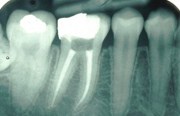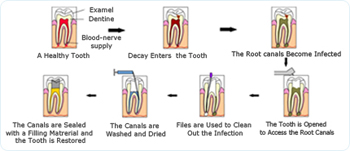Root Canal Treatment
What is root canal treatment?

A human tooth can broadly be divided into two parts i.e. crown and root. The crown consists of – enamel, gum and dentin; on the other hand the root section of the tooth consists of – pulp chamber, root canal containing pulp tissue, bone, supporting ligament, root end opening etc. The soft pulp under the hard dentin layer is contains blood vessels, nerves and connective tissue and is responsible for growth and development of the hard tissues surrounding the tooth. If the tooth is fully matured, it will survive without the pulp because of the nourishment given by the surrounding tissues.
The root canal treatment is a dental procedure wherein the tooth can be fixed by removing the pulp chamber of the tooth and filling it with an apt filler material. This is normally done when the tooth can neither be filled nor restored by any other means and this is due to the fact that the decay has reached the tooth nerve or the tooth has become infected.
You can prevent extraction of the tooth by performing the root canal treatment on the tooth whose nerve has been killed or severely decayed or damaged and this is the final attempt to save the tooth prior to extraction. If the RCT is successful, all the germs in the root area would have been removed and this tooth can last for a very long time.
The root canal treatment is known by various names – RCT, endodontic treatment, Root canal or Root canal therapy. The origin of the word endodontic is from two Greek words “Endo” – meaning inside – and “odont” meaning tooth”. This treatment is basically is meant for treating the inside of the tooth.
What is the necessity for root canal treatment?
The root canal treatment becomes essential if the pulp tissue inside the root canal gets inflamed or infected thereby affecting the blood / nerve supply to the pulp. This can be due to various reasons such as deep decay, crack or chip in the tooth and also if dental procedures on the tooth are repeated often. If there is injury to the tooth it could cause damage to the pulp in spite of not having any visible cracks. An untreated pulp inflammation or infection might lead to pain or abscess. You may not feel any pain in the early stages of the infection. In some cases, your tooth could become dark thereby indicating that the tooth nerve is dead.

If the pulp becomes infected, the infection spreads through the root canal system of the tooth thereby causing abscess formation. The abscess might cause dull ache to severe pain and you will observe that the tooth shows tenderness while biting. In the absence of a root canal treatment (RCT) the infection will spread resulting in tooth loss.
What are the signs that necessitate Root Canal Treatment?
- Drainage, swelling and tenderness in the lymph nodes, bone and gingival tissues.
- Extended sensitivity to heat or cold
- Pain
- Tenderness to chewing and touch
- Tooth discoloration
- No visible symptoms at times
What does it involve in saving the tooth?
The objective of this treatment is to remove all infection from the root canal. The Endodontist removes the infected or inflamed pulp, cleans it thoroughly inside and fills up the space with approved filler material to prevent any further infection. The dentist will place a crown or any other restoration on the tooth to protect it. RCT is a skilled and time-consuming procedure and requires two or more visits to your dentist.
What are the steps involved in RCT?
The steps involved are as follows:
-
- After examining physically the tooth and also its x-rays the dentist/ endodontist administers local anesthetic. Once the tooth becomes numb, the dentist places a small protective sheet called a “dental dam” over the area in order to isolate the tooth; this will ensure that the tooth is clean and free from saliva during the treatment.
- An opening is made in the tooth crown and using mini instruments the pulp chamber and root canal are cleaned and shaped to suit filling.
- To protect the tooth the dentist will provide a crown or other restoration after which the tooth becomes fully functional.
- If the tooth structure is unable to hold the restoration in position, your dentist might provide a post inside the tooth.

Does it pain either during the procedure or after it?
The purpose of root canal treatment is to relieve the tooth pain caused by pulp infection or inflammation. During the procedure a local anesthetic is given and the patient hardly feels any pain. Your tooth becomes sensitive for the first few days after treatment, that too if there was pain or infection before the procedure. This can be relieved with OTC or prescription medications. After the treatment your treated teeth might feel different for sometime.
How does my tooth look like post-treatment?
In the earlier days a root canal treated tooth often becomes dark. However, modern techniques prevent such an occurrence. Even if the discoloration happens it can be brought to natural color by using various techniques.
Is there any possibility of this problem repeating again?
Normally RCT is successful in most of the cases. However, in the event of this problem coming back the same treatment can be repeated. New infection or inflammation can be caused by new trauma, deep decay, or a loose/ cracked/ broken filling can cause new infection in your tooth. In some cases, the endodontist may find canals that are narrow or curved that was not found during the initial procedure and this requires treatment.
Is it absolutely necessary to treat RCT?
Infection or inflammation destroys the pulp in the pulp chamber and hence it won’t heal. It is not desirable to leave the infected tooth inside the mouth. Pain and swelling can occur if the infected pulp is not removed and the byproducts of the infection could injure your jaw bones. If you do not get RCT done then the alternative is to extract your tooth. Always it is advisable to retain your natural teeth as much as possible.
What care you should take after RCT?
The tooth treated by RCT requires the same care as your natural tooth. However, this tooth should not be used for chewing or biting until unless it is restored by your dentist; this is due to the fact that this tooth is susceptible to fracture. In addition you must practice good oral hygiene that includes brushing with fluoride paste, flossing, cleanings etc. Avoid sugary snacks as much as possible.
Are there any constraints in treating the teeth with RCT?
Normally most of the teeth can be treated; however there could be certain occasions wherein it is not possible for doing RCT; for example, inaccessibility of root canals, severely fractured tooth, inadequate bone support etc. With advancement in endodontics such incidences are becoming rare. If the RCT is ineffective endodontic surgery could help in saving the teeth.
How safe is RCT?
In the US, 20 million root canals are being performed in a year and it is increasing day by day. By subjecting a patient to root canal treatment you are allowing a dead tooth to be kept in his mouth. The body normally does not like anything dead to be kept inside it and tries its best to get rid of it.
Saving tooth by RCT is a matter of dental convenience and it has been found to be relatively safe in most of the cases. However, in some people it compromises on the immune system thereby causing diseases. In addition, a dead tooth is likely to become more brittle thereby warranting extra support and strength by fixing a crown.
Frequently Asked Question
What does the root canal treatment involve?
The purpose of the root canal treatment is to eliminate the infection from the root canal completely. The root is cleaned after that and filled in order to prevent further infection.
Does root canal treatment hurt?
No, we use a local anesthetic, so that you can have the treatment without any discomfort. You may feel some tenderness after the treatment, but it will decrease gradually.
How many appointments are required to complete the treatment?
Mostly root canal treatment is completed in one visit. You may require a second or third visit if the condition is complicated.
Why do I need root canal treatment?
To control pain and further infection, you need a root canal treatment. Your tooth will be saved now, otherwise, the tooth needs to be removed and replaced with artificial teeth.
Will the teeth be safe after the treatment?
Yes, however, dead tooths are weaker, therefore, you may require a crown to provide extra strength and support to the tooth.




